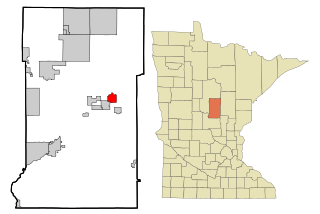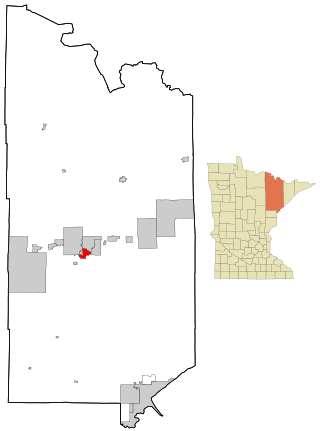Schroeder Township is one of the three townships of Cook County, Minnesota, United States. The population was 187 at the 2000 census. The unincorporated communities of Schroeder and Taconite Harbor are located within the township. The community was named for John Schroeder, a businessperson in the lumber industry.

Cuyuna is a city in Crow Wing County, Minnesota, United States. The population was 332 at the 2010 census. It is part of the Brainerd Micropolitan Statistical Area.

Winnebago is a city in Faribault County, Minnesota, United States. The population was 1,391 at the 2020 census.

Bovey is a city in Itasca County, Minnesota, United States. It is part of Minnesota's Iron Range. The population was 804 at the 2010 census.

Cohasset is a city in Itasca County, Minnesota, United States. The population was 2,698 at the 2010 census.

Coleraine is a city in Itasca County, Minnesota, United States. The population was 1,970 at the 2010 census. The community was named after Thomas F. Cole, President of the Oliver Iron Mining Company.
Iron Range Township was a township in Itasca County, Minnesota, United States. The population was 649 at the 2010 census.

Keewatin is a city in Itasca County, Minnesota, United States. The population was 1,068 at the 2010 census.

Taconite is a city in Itasca County, Minnesota, United States. The population was 360 at the 2010 census.

Silver Bay is a city in Lake County, Minnesota, United States. The population was 1,857 at the time of the 2020 census. It is the largest population center in a natural tourism area which includes, Tettegouche State Park and the Split Rock Lighthouse. It is a port along Lake Superior for iron ore and has taconite mining facilities of its own.

Aurora is a city in Saint Louis County, Minnesota, United States. The population was 1,678 at the 2020 census.

Babbitt is a city in Saint Louis County, Minnesota, United States. As of the 2020 census, the city had a population of 1,397.
Cherry Township is a township in Saint Louis County, Minnesota, United States. The population was 860 at the 2010 census.

Eveleth is a city in St. Louis County, Minnesota, United States. The population was 3,718 at the 2010 census.

Gilbert is a city in St. Louis County, Minnesota, United States. The population was 1,799 at the 2010 census. State Highway 37 and State Highway 135 are two of the main routes in Gilbert. Gilbert is part of the Quad Cities, with Virginia, Eveleth, and Mountain Iron. The city is named for Giles Gilbert, who led the exploration of the McKinley mine property in the 1890s.

Great Scott Township is a township in Saint Louis County, Minnesota, United States. The population was 561 at the 2010 census.

Kinney is a city in Saint Louis County, Minnesota, United States. The population was 169 at the time of the 2010 census.
Kugler Township is a township in Saint Louis County, Minnesota, United States. The population was 175 at the 2010 census.

McKinley is a city in Saint Louis County, Minnesota, United States; located within the Iron Range region of Minnesota. The population was 128 at the 2010 census.
Wuori Township is a township in Saint Louis County, Minnesota, United States. The population was 572 at the 2010 census.


















